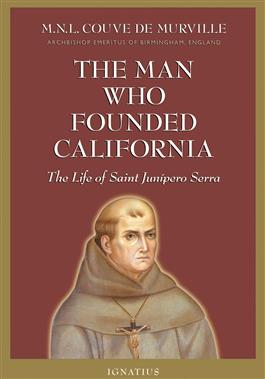 The Man Who Founded California is a reprint of a 2000 hardcover edition, also by Ignatius Press. The book begins by talking about the statues on the U.S. Capitol's Statuary Hall. St. Junípero Serra currently has a place there, but probably not for long, as he will soon be replaced by Sally Ride.
The Man Who Founded California is a reprint of a 2000 hardcover edition, also by Ignatius Press. The book begins by talking about the statues on the U.S. Capitol's Statuary Hall. St. Junípero Serra currently has a place there, but probably not for long, as he will soon be replaced by Sally Ride.
The book then leads us into a differentiation between Spaniards and Majorcans, which is what Serra was, in fact. Majorca is the largest island off the Spanish coast, but they don't share a language or really a culture. Majorca claims a more Mediterranean heritage. They also have a small Catholic population, which is evidenced by only having one bishop. Because of the lack of a convenient bishop, people received sacraments at different ages. Serra, for example, was confirmed before he was two! At age fifteen, he told his parents he wanted to be a priest, which was a sacrifice for the poor farming family, but one they accepted. The chapter on Majorca ends with Fr. Serra and other Dominicans and Franciscans arriving to Mexico for missionary work.
 Fr. Serra and one other friar decided to walk from Vera Cruz (where the boat landed) to Mexico City. This was keeping with the Rule of St. Francis and was also a form of penance for the mission they were about to embark upon. What we learn in this chapter dealt primarily with the different aspects the mission. For starters, the mission was trying to unite all of the Indian people. Another component was that these people were seen as uneducated and childlike, which unfortunately heavily restricted their freedom. However, their culture was considered when it came to spiritual education as they realized the cultural affinity for music and drama. Lastly, we learn that Fr. Serra was responsible for building the church at Jalpan.
Fr. Serra and one other friar decided to walk from Vera Cruz (where the boat landed) to Mexico City. This was keeping with the Rule of St. Francis and was also a form of penance for the mission they were about to embark upon. What we learn in this chapter dealt primarily with the different aspects the mission. For starters, the mission was trying to unite all of the Indian people. Another component was that these people were seen as uneducated and childlike, which unfortunately heavily restricted their freedom. However, their culture was considered when it came to spiritual education as they realized the cultural affinity for music and drama. Lastly, we learn that Fr. Serra was responsible for building the church at Jalpan.
The final and longest chapter focuses on his time in California. The main positives of Serra's time in California was reflected in the missions he founded, including San Diego, San Juan Capistrano, and Santa Clara to name only three. However, there were also negatives with his time there, which included the isolation he felt from the rest of the world and the poor actions the Spanish soldiers performed against the natives. Serra was opposed to this kind of behavior, and the book says he complained about it, but it seemed like more should have been done to stop it.
The book is FULL of photographs and illustrations that aid the reader in better understanding the life and mission of Fr. Serra. I knew nothing about Serra before reading this book, but after reading it, I feel I have at least a basic understanding. Those looking for a shining story of perfection need look elsewhere. Serra is indeed a saint, but saints were still men and women, just like the rest of us. They sinned, but they sought forgiveness, just like we should. They were also always striving to do the will of God and spread his Gospel message. Overall, I found this book to be a solid introduction on Serra's life and work. If you are like me and need a book to start with on Serra, this is the one.
Be sure to check out our Book Notes archive.
Your purchase of The Man Who Founded California through our affiliate link helps support CatholicMom.com but costs you nothing extra.
About the Author

Stuart Dunn
Stuart Dunn was born and raised in Mobile, AL and received a Bachelor of Arts in Psychology and a Master of Business Administration from the University of South Alabama. Stuart reviews all things Catholic including adult books, children’s books, Bible Study series, Catholic Courses, CDs, and DVDs in addition to board games at his blog Stuart’s Study at StuartsStudy.blogspot.com.


.png?width=1806&height=731&name=CatholicMom_hcfm_logo1_pos_871c_2728c%20(002).png)
Comments